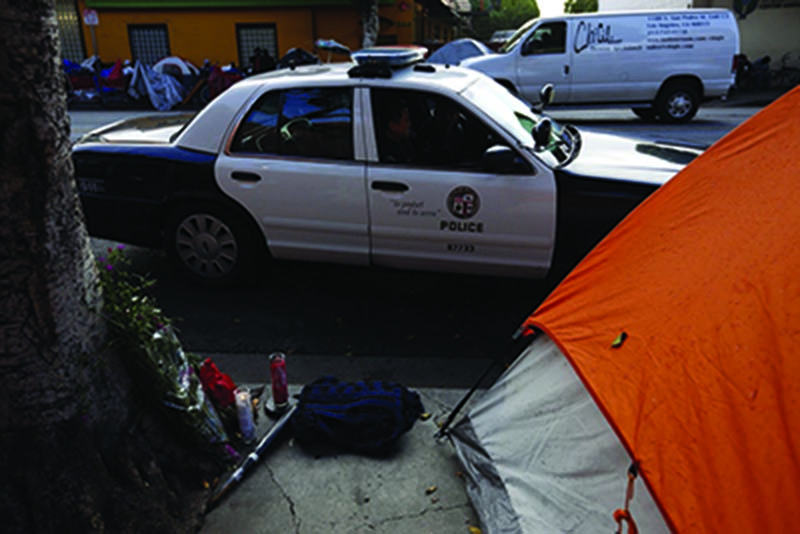Police shootings are always a subject of debate. This topic has been the center of the controversy surrounding the recent shooting that took place March 1, 2015. Police were dispatched to the scene in response to an attempted robbery. They soon confronted their suspect, a homeless man known as “Africa”, and attempted to subdue the man with a Taser. The man was alleged to have mental problems. In the chaos that followed the man continued to fight police when he then reached for one of the officer’s service pistols. Police then fired five rounds into the suspect, killing him instantly.
On the one hand people see these events and automatically scream “Police brutality!” With the recent Michael Brown shooting still fresh in peoples’ minds this recent incident is just further evidence that police are rising above the law and delivering their own version of street justice. They have their reasoning; no one wants to live in fear of the people that have been put in place to protect them.
On the other hand, police and their supporters will say that any officer worth their badge would never apply deadly force without due cause. For the purpose of this article, the author would like to address that he will be using the police department under scrutiny, the Los Angeles Police Department, as his example and source of information regarding crime statistics and use of force reports.
Being a police officer is a dangerous undertaking. These men and women essentially put a bull’s eye on their back every time they don the blues. According to odmp.org the LAPD has seen 204 of its best and brightest killed in the line of duty since its inception in 1869. Of those 204, more than half of those deaths are caused by an assailant. That’s 111 deaths. Of those 111, 99 were the direct result of a shootout. With all the different ways an officer can die in the line of duty, medical causes and accidents included, almost half of all deaths were related to firearms being fired at police officers with the intent to kill them.
This is a terrifying concept for many officers across the country and can impact their decision making. It doesn’t help that those actively trying to kill them don’t act on a code of conduct or force continuum. That’s the funny thing that nobody critical of the police likes to bring up. There is no legitimate job out there, federal or otherwise, where its employees are authorized to kill that doesn’t have a set of policies and guidelines to follow. This is ingrained in police officers across the country to the point that virtually every good officer will be able to recite the policy to deadly force verbatim. The LAPD’s policy on deadly force goes as follows:
“Law enforcement officers are authorized to use deadly force to:
Protect themselves or others from what is reasonably believed to be an imminent threat of death or serious bodily injury; or,
Prevent a crime where the suspects actions place person(s) in imminent jeopardy of death or serious bodily injury; or,
Prevent the escape of a violent fleeing felon when there is probable cause to believe the escape will pose a significant threat of death or serious bodily injury to the officer or others if apprehension is delayed. In this circumstance, officers shall, to the extent practical, avoid using deadly force that might subject innocent bystanders or hostages to possible death or injury. “
As can be seen in the above policy deadly force is to be applied only when there is “an imminent threat.” This obviously leaves a gray area that leaves many people uncomfortable. What constitutes “an imminent threat?” This is a concept that cannot be set to one standard as no one person is the same.
For example, an officer small of build may pursue a violent suspect twice their size. Given an influx of calls, back up cannot arrive in a timely manner, but the suspect in question is endangering the lives of civilians. The officer has no other choice but to attempt an arrest. Now, if the suspect were to gain the upper hand, what would the officer be left with? Dying because he or she wasn’t the physical equal? What if the suspect in question was high on mind altering substances that blocked off pain receptors? What if deadly force wasn’t just the best choice, but the only choice in stopping the violence?
How about shooting to wound? Warning shots? This is another argument that gets brought up regularly by people who have never been trained in use of force. Coming from both a military and law enforcement background, the author has had extensive knowledge in this particular subject, and has asked and been asked these questions regularly. To be put simply, shooting a suspect is the last resort for any police officer. The situation has come to the point that the only way to deescalate the situation and ensure the safety of oneself, fellow officers and bystanders is to act immediately. Attempting to wound, graze or scare an assailant is not only cruel and unusual, it opens up the potential for an accidental injury or death due to the officer’s failure to act. By attempting to shoot someone in the arm or leg, the round might ricochet and hit an innocent person. The person may act even more aggressively, or even end up killing someone since they haven’t already been incapacitated.
Many people who weren’t on scene may never know what really happened, and even those on scene do not see what’s going on from that officer’s perspective. He or she may genuinely fear for their life and see the situation unfold to the point where deadly force must be used.
Officers carry this burden with them every day. This isn’t a decision that is taken lightly. This past year there were only two incidents that LA police officers used deadly force. Clearly, deadly force isn’t the go to cover all that so many people claim it is for police officers. There is an inherent fear that every officer on duty faces; that he will be the one to wrongfully kill another human being. But greater than that fear is one more deeply rooted to his job; that he will get one of his fellow officers or the civilians he’s charged to protect killed if he does not act. It is these two fears that will motivate an officer to make a decision. As a society, the United States needs to understand this and give the boys in blue a bit of leeway. These men and women risk their lives every day to keep communities safe. Let’s entrust that they know what they’re doing.




